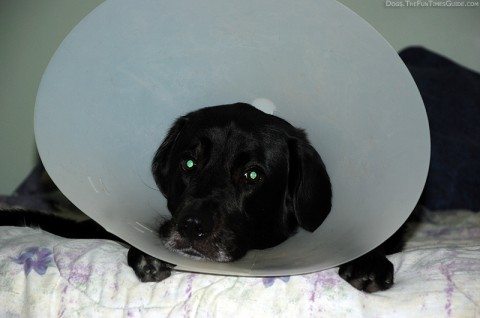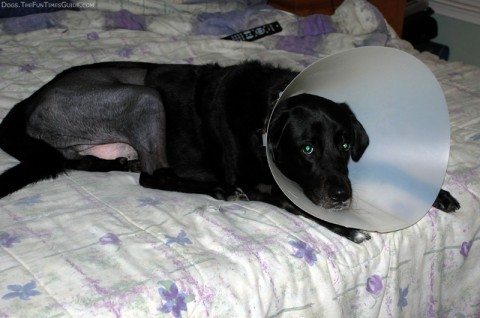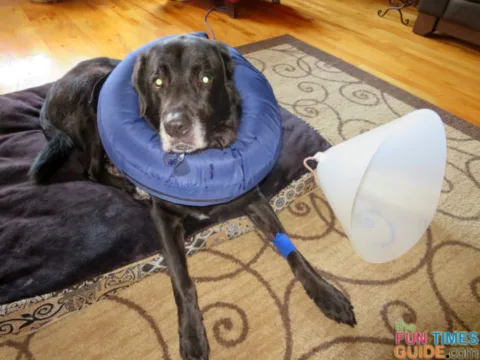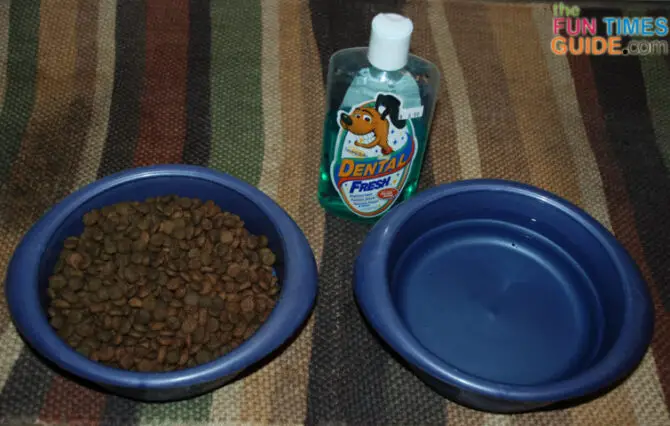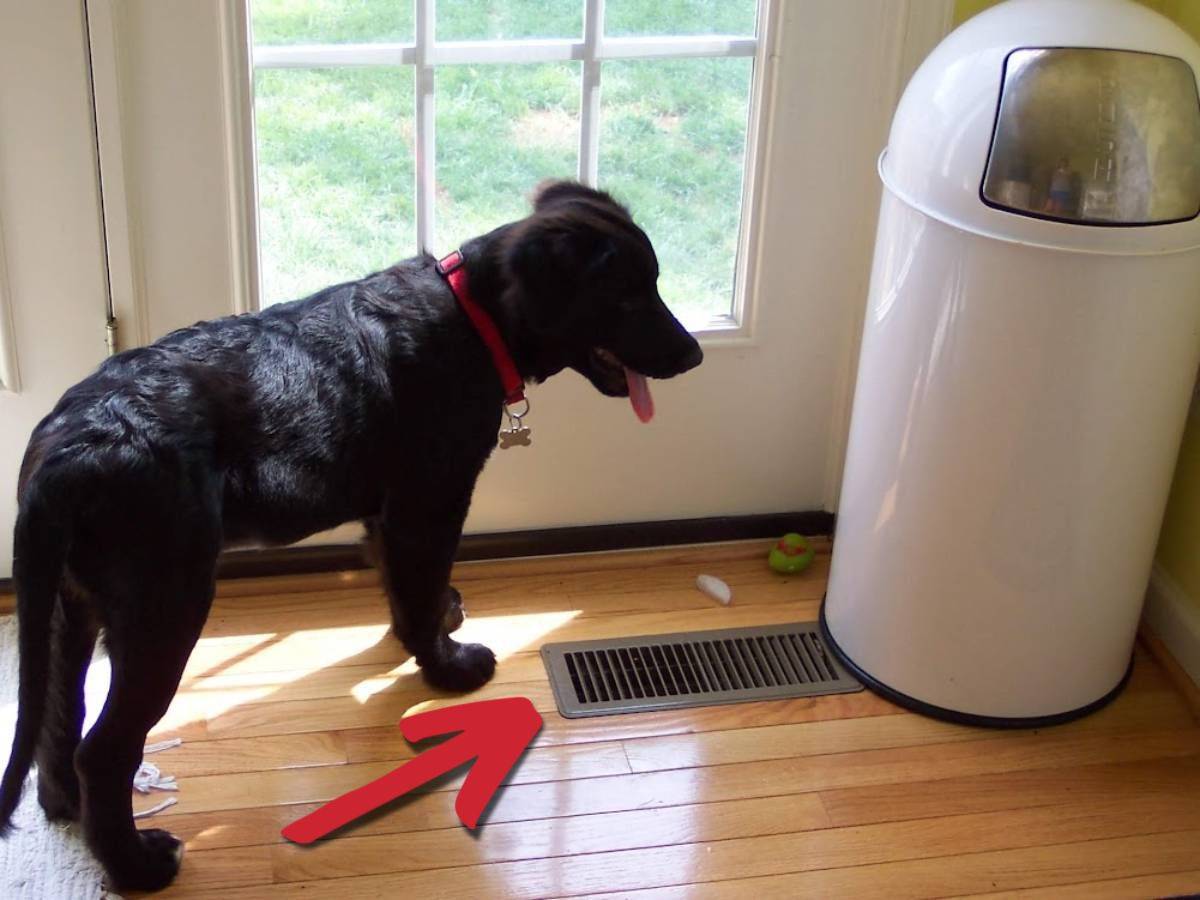Remember this post where I bragged about us not having to use a cone-shaped e-collar with our dog after TPLO surgery because he wasn’t all that interested in licking his surgical wound?…
And remember how proud I was that every time we could tell that he was thinking about licking at the site of the incision, we would immediately tell him “NO LICK!” — which would scare him enough not to want to lick at it?…
Well, much to my dismay, our Tenor dog changed his mind.
In the 20 minutes we left him alone while we caught up on things around the house the other day, Tenor had enough time to discover what it was like to lick his wounds.
And it wasn’t pretty.
While he didn’t do much damage, he did make it bleed a bit. This was Day 7 after surgery, so there really wasn’t much to bleed at this point. The wound, while still tender, was fairly well healed, believe it or not.
Turns out the moist blood droplet we saw after Tenor’s solitary licking session was actually coming from between the folds in a doubled-over surgical site. Meaning, they folded a part of Tenor’s leg skin over itself to create an extra thick suture (and probably a very thick scar when it’s all said and done).
Anyway, there was no “leaking” blood, as we had experienced before with our other dog’s surgery. Tenor had just moistened the area quite well.
Not ideal, mind you. But not life-threatening either.
Nonetheless, we learned that we can’t take our eyes off of him for a MOMENT until those stitches had completely disintegrated!
The worst part…
Immediately after it happened, he was reminded about that part of his leg and he couldn’t seem to get his attention off of it. Every chance he got, he felt the urge to lick it.
Thus began our nightly routine of using the “cone of shame” (aka E-collar or Elizabethan collar).
The Basic Cone Collar Really Works!
To tell you the truth, I wish so badly that we had given in to using this post-surgery dog recovery collar earlier.
We didn’t because we felt bad for the dog. We thought he would be “scared” of it or feel “punished.”
Pffft! No need to feel bad for something that will protect your dog and make them heal faster. (And get you a few extra hours of sleep!)
If I had this to do all over again, I would definitely use the dog recovery collar at night (and any time we had to leave him alone). I would do this simply for our own sanity. You cannot watch a dog 24 hours a day, no matter what you think. We tried. We failed. It wasn’t a major ordeal… just a lesson learned.
I think it happened when it did because at Day 7 post-op, his skin was getting especially dry and itchy. Even flaky. So it was more noticeable to him.
Okay, so now I am a sincere advocate of recovery collars to protect dogs after surgeries and injuries.
We’ve been using the “cone of shame” for the past 3 nights now. So far so good. We all get a good night’s sleep. And his leg heals faster.
In fact, I think Tenor may actually like the cone collar! Within moments of me putting it on him, he’s out like a light and snoring like a freight train.
Maybe it helps him “tune out” things a bit… he definitely seems to sleep well when he’s wearing it.
Alternatives To Traditional Dog Cone Collars
The doctor who did Tenor’s TPLO surgery charged $17 for the cone collar he sent us home with. (It’s a Large size “25” for our 75 lb dog.)
That led me to become intrigued to see how much they really cost, and what other types of recovery collars for dogs might be out there.
I figured there were probably some new post-surgery dog collars available these days that would be far less awkward, less intrusive, and maybe even simpler to attach than the old-fashioned cone collar.
Here’s what I’ve learned…
Modern Cone Collars For Dogs
The most commonly used — and usually effective measure — is the collar that fits around the neck and prevents the dog from having access to the area … The Elizabethan collar looks like a lampshade and surrounds the pet’s head, preventing him from getting to the wounded area. The disadvantage is that it takes the pet a few days to get used to the collar. They bang into furniture, walls, the floor and your legs; some will not eat. Fortunately, the collar can be removed when you are around to supervise and easily replaced when you are not available. One advantage is that the collar also prevents your pet from being able to scratch at any injuries or wounds on the face.
— PetPlace.com
The cone-shaped dog recovery collars come in all sizes and colors these days. The major differences are in the way these cone collars secure onto the dog and “stay in place.”
Several different companies make a basic lampshade style dog e-collar in various colors and with methods of attaching them to your dog (string, velcro, etc).
Here are some EXAMPLES of modern cone collars:
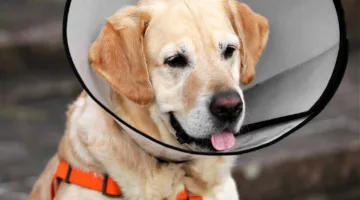
- This Supet cone of shame is most similar to the Elizabethan dog collars of the past because it has that simple string that secures the collar onto your dog’s neck. The best modern feature to this one is the soft edges around the dog’s neck and around the outer edge. It’s also one of the most affordable!
- The Comfy Cone is collapsible and foldable, yet rigid and strong. It can even be folded back temporarily — so your dog can eat or drink.
- The Kong Company (maker of Kong dog toys) also makes an EZ Soft Collar that’s in the traditional cone shape.
- Megeo dog recovery collars are soft yet very sturdy in that traditional cone shape. I like that they’re longer than most making it less likely your dog could reach their sore spot to lick it.
- The Supet adjustable dog cone collar is one of the most highly rated recovery collars for dogs due to its soft edge at the dog’s neck and its adjustability.
A few downsides associated with hard plastic cone collars:
- Can be painful around the neck of the dog — due to the sharp edge and durability of the hard plastic material.
- Can be noisy — every time your dog passes by something or bumps into anything, you will hear the scraping of hard plastic.
- Limiting to your dog’s field of vision – it’s difficult for the dog to see what’s ahead to the right and ahead to the left. They can pretty much only see what’s directly in front of them.
- Can be scary for some dogs — these collars create blindspots and amplify sounds. If your dog is super timid, I would choose a softer version of the cone collar instead of the hard plastic one.
- Can cause bruises on the legs of some dog owners — you will likely end up with some bruising on your own legs from your dog aimlessly bumping into you with their “cone of shame” on.
Alternative Recovery Collars For Dogs
Another neck collar is based on the principle that if the pet cannot turn his head to get at the injured area, he cannot lick. These firm collars fit around the neck similar to a neck brace. The pet is not able to flex his head enough to get at the wound. These collars do not work too well if the injury is on the front legs but does prevent the pet from contorting and reaching his side or back end.
— PetPlace.com
Most of the newer versions of the traditional Elizabethan collar don’t have the same thick lampshade “cone” effect. Instead, they are generally softer, more flexible, and a tad less claustrophobic for the dog.
While designed to keep enough space between your dog’s mouth and his other parts, their effectiveness is dependent on your dog and how aggressively they can work around this obstacle.
I would say that it is slightly easier for a dog to manipulate these softer recovery collars than it is for a dog to outwit the standard lampshade e-collar that has been recommended by veterinarians for years.
But if you’re looking for an alternative to the cone-shaped ecollar, these are definitely worth a try!
Here are some EXAMPLES of alternative recovery collars:
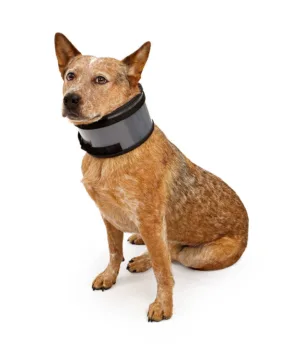
- Neck’s Best Thing is a multi-sized and adjustable “brace” to fit every dog. The dog wears it exactly as we would wear a neck brace after an accident. It restricts a lot of movement in the neck area — for the dog’s safety.
- The Bencmate inflatable collar for dogs is probably the most popular choice among pet owners. It’s a donut-shaped recovery collar and comes in lots of fun colors and designs.
- The BiteNot Collar is a flexible plastic and foam collar that is washable. It’s similar to a neck brace.
- The Kong Company also makes a soft, fabric inflatable donut-style recovery collar for dogs.
- This rainbow-colored dog recovery collar from Ccypet allows you to show off your own personality (and your dog’s). One thing’s for sure, your dog certainly won’t go unnoticed! NOTE: With this recovery collar, your dog will still be able to lick their paws.
Thinking Outside The Box…
Depending on where your dog’s injury is, here’s another great alternative to using a dog recovery collar:
By putting dog boots (aka muttluks) on each of your dog’s paws, your dog will be less inclined to scratch himself while wearing them!
This works best where the dog’s injury is confined to the head or upper body area — because the dog would still be able to lick other spots on the body with ease.
The Bottom Line
One thing you should know is that the standard hard plastic Elizabethan cone collar is the absolute best at preventing your dog from being able to use their paws to scratch any injuries or wounds on the face. Most of the other soft recovery collars and neck brace types of collars don’t offer this same level of protection.
Why not? Because most of the other types of cone recovery collars are simply too short (the distance from neck to nose).
The longer that distance is between the outer edge of the collar (the part that runs into things) and the inner edge of the collar (that attaches to your dog’s neck is), the less likely your dog will be able to put one of their paws on the affected area… or even extend their tongue far enough to lick at that spot on their body.
TIP: Make sure that you get a properly fitted dog recovery collar by accurately measuring from your dog’s neck to your dog’s nose. Otherwise, there’s the possibility that your dog could “shake” it off or otherwise slip out of it.
Also, the softer your dog’s recovery collar is, the more easily they could “push” their way far enough to reach the wound — because softer recovery collars have some “give” to them.
And… just know that some dogs feel as if they’re being restrained – or punished – as soon as a recovery collar is placed on them. They may completely “shut down” when they have it on. ALL of my dogs did this the very first time they wore a recovery collar – but they all quickly got past their fears and first impressions of the “cone of shame”.
Regardless of which type of dog recovery collar you choose, just know that a very persistent dog may still become frustrated enough with it that they could manage to get the collar off or be able to reach the wound area.
No matter which type of recovery collar you choose, you will still need to keep an eye on your dog until you learn their level of acceptance with the type of recovery collar you’ve chosen. It typically takes a couple days for a dog to get used to wearing it — simply because they have something strange around their neck that they’re not used to. So watch your dog closely for those first few days!
Features To Look For In Dog Recovery Collars:
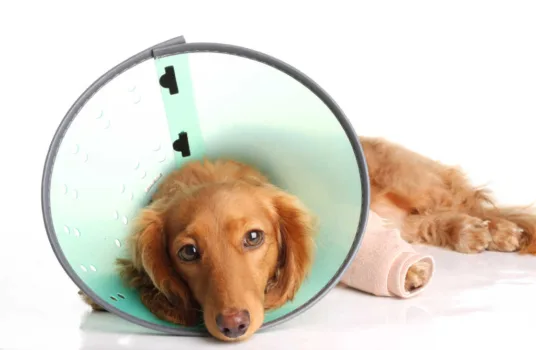
- One of the biggest issues with dog recovery collars is how quickly you can put them on and take them off.
- Another issue is how securely fastened the collar will remain throughout your dog’s day.
- It would be ideal for the dog’s recovery collar to be transparent and clear in color (instead of some other color, even white) — making it easier for your dog to see in front and around them.
- You also want it to be easy to clean. Dog drool (and food smears) are a given on the inside of recovery collars. You want that stuff to easily wipe off.
- The final thing is durability. The recovery collar’s ability to withstand being bumped, bent, and scratched is important. You want to be able to reuse whatever collar you buy – in the event of future surgeries or emergencies arising.
UPDATE #1:
A total of 5 nights with the cone collar were all that we needed with Tenor after TPLO surgery. It was just during that time when his leg got dry and itchy — and when left alone — that he was inclined to lick at it. Now, at exactly 2 weeks post-op, Tenor’s incision “looks” completely healed. While still tender, you can’t see the stitches anymore, and his leg isn’t so dry anymore either. Now, we’re back to just watching him closely, but he’s more interested in walking on it at this point, and less interested in licking it. Yay!
UPDATE #2:
I have since used an inflatable dog collar with this same dog and had great results.
It was for a hot spot on his leg — many years after my dog’s TPLO surgery:


